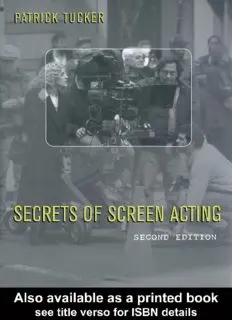
Secrets of Screen Acting (Theatre Arts Book) PDF
Preview Secrets of Screen Acting (Theatre Arts Book)
SECRETS OF SCREEN ACTING SECRETS OF SCREEN ACTING SECOND EDITION PATRICK TUCKER ILLUSTRATIONS BY JOHN STAMP A THEATRE ARTS BOOK ROUTLEDGE NEW YORK AND LONDON A Theatre Arts Book Published in 2003 by Routledge 29 West 35th Street New York, NY 10001 www.routledge-ny.com Published in Great Britain by Routledge 11 New Fetter Lane London EC4P 4EE www.routledge.co.uk Routledge is an imprint of the Taylor & Francis Group. This edition published in the Taylor & Francis e-Library, 2005. “To purchase your own copy of this or any of Taylor & Francis or Routledge’s collection of thousands of eBooks please go to www.eBookstore.tandf.co.uk.” Copyright © 1994 by Routlege Copyright © 2003 by Taylor and Francis Books, Inc. All rights reserved. No part of this book may be reprinted or reproduced or utilized in any form or by any electronic, mechanical, or other means, now known or here after invented, including photocopying and recording, or in any information storage or retrieval system without permission in writing from the publisher. Library of Congress Cataloging in Publication Data Tucker, Patrick. Secrets of screen acting/Patrick Tucker; illustrations by John Stamp. —2nd ed., rev. and updated p. cm. “A Theatre arts book.” Includes bibliographical references and index. ISBN 0-87830-177-1 (Print Edition) (PB: alk. paper) 1. Motion picture acting—Vocational guidance. 2. Television acting—Vocational guidance. I. Title. PN1995.9.A26T8 2003 791.43'028'023–dc21 2003007434 ISBN 0-203-01109-0 Master e-book ISBN For my partner, Christine Contents Preface to Second Edition vii Acknowledgments ix Introduction x 1. SCREEN VERSUS STAGE 1 2. FILM VERSUS TELEVISION 18 3. THE FRAME 32 4. THE CAMERA 43 5. REACTIONS AND BUSINESS 55 6. SOUND AND VOCAL LEVELS 70 7. TYPECASTING 84 8. ACTING 1 00 9. AUDITIONS 1 15 10. REHEARSALS AND TECHNICALS 1 32 11. DIRECTING ACTORS FOR THE SCREEN 1 43 12. ANNOUNCERS (AND THE ART OF BEING 1 52 INTERVIEWED) 13. THE SHOOT 1 58 14. THE EDITOR AND EDITING 1 77 Epilogue 1 85 The Famous Screen Acting Checklist 1 87 Acting Exercises 1 94 vi Bibliography 2 07 Biographies 2 10 Glossary 2 13 Index 2 33 Preface to Second Edition I have been revisiting this book ten years after writing it, and in the interim many changes have happened in our profession that affect the actors and others who work in it. The rehearsal time has now all but disappeared, and since the industry is now finding those actors who can without rehearsing produce the goodies— or their version of the goodies—I can see no reason why producers in the future will reintroduce rehearsal time. There is also a growing use of the wide screen ratio being used in television—and that changes the way it is shot, which affects the actors and how they perform. More and more films go “straight to video,” and quite a few prestigious television dramas are upgraded during filming (when things are going very well) to allow the possibility of being shown on the big screen as a feature film. High definition digital filming is coming into both film and television, leading to a rapid increase in the convergence between the two worlds. The repercussions of all these events are dealt with in this revised edition, together with extra thoughts and corrections that time has shown to be needed. I have taken the opportunity to update the references to performances to be of a more recent vintage. The changes to our profession are also reflected in the Glossary, which has been extensively extended with more than fifty new entries, giving defi nitions of new phrases and words now in use, and the Bibliography has also been updated with new books. I still marvel that current practitioners can say, as a recent book puts it, that screen acting compared with stage acting suggests that “a more subtle and natural acting style is viii needed.” Have they really watched and listened to what current screen actors actually do? Patrick Tucker London, 2003 Acknowledgments This book started with a letter: “Sometimes the way to get books to happen is to put contracts in the post. So I’m doing just that,” and so without Bill Germano’s spur, and the support from the team at Routledge, this book would not have started or finished. I started to write it when I was working on television dramas in Vordingborg, Denmark; Dublin, Ireland; and Liverpool, England; and finished in London and New York; so directly and indirectly I owe thanks to TV2 Øst’s Landsbyen, Radio Telefís Éireann’s Fair City, and Mersey Televisions Brookside. I started my screen acting classes in 1975 at the Drama Studio London, and have continued there and at the Webber Douglas Academy for Dramatic Art ever since. My thanks go to the two Principals involved, Peter Layton and Raphael Jago, who have encouraged me to present and develop a brand new acting class. Thanks also go to all those in New York, especially the Margots, who have helped me bring my Screen Acting Workshops to New York so successfully over the years. Finally, my thanks are due to Andrew Tucker for his work on the index, and to Christine who, amongst many other burdens, had to sit through the Rambo films counting how many words were spoken by the action hero.
